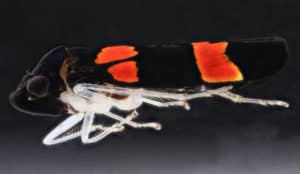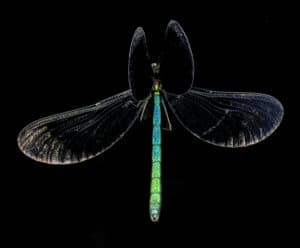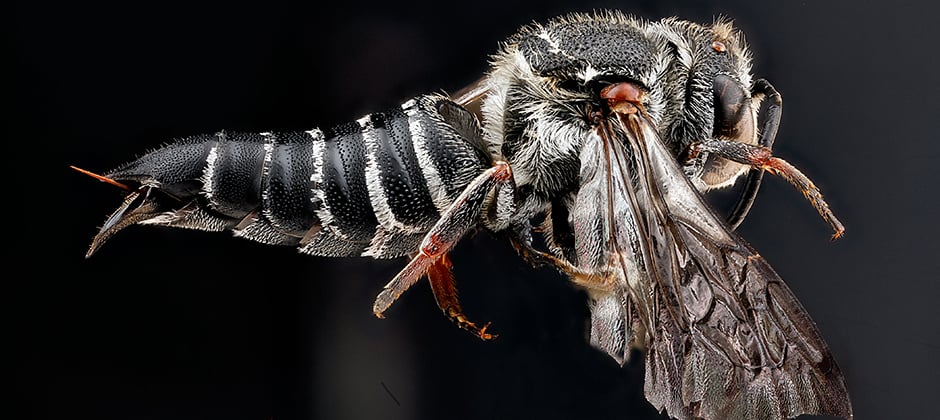Share this article
Light pollution a major driver of world insect declines
Artificial light plays a large — and overlooked — role in ongoing insect declines around the world, researchers found.
“Light pollution is growing very quickly,” said Brett Seymoure, a postdoctoral fellow at Washington University in St. Louis and the lead author of a study published recently in Biological Conservation. “It’s growing at a much faster rate than [human] population growth.”
A number of recent studies have been tracking an ongoing “insect apocalypse.” One review published in April shows found that 40% of insect species face extinction, including land insects like dung beetles, butterflies, moths, wasps, sawflies, bees and ants. Aquatic insects like dragonflies and damselflies, stoneflies, caddisflies and mayflies have already lost a number of species, the review found.

A leafhopper collected in the Dominican Republic.
Credit: Sam Droege, USGS Bee Inventory and Monitoring Lab
That study found that the reasons for these declines, in order of importance, were habitat loss, pollution from synthetic pesticides and fertilizers, introduced species and pathogens and climate change.
But Seymoure said that this review failed to mention light pollution, which his team concluded is a major driver of insect decline.
“A lot of insect scientists who were studying the biodiversity loss of insects weren’t paying attention to light,” Seymoure said.
His research has shown that some insects are highly sensitive to specific light conditions. Many butterflies, for example, will choose areas with very specific lighting in rainforests — some prefer more open canopy areas with plenty of light, while others prefer partial or dappled shade. These conditions can be important for helping insects camouflage from predators or advertise their colors and patterns to attract mates.
Even their vision may be adapted to work best in certain light conditions, Seymoure said. But artificial light can have a big impact on this at night, throwing mating habits out of whack or making them more susceptible to predators, with effects that can stretch hundreds of miles from the sky glow of urban areas.
Massive decline

Harlequin bug (Murgantia histrionic) eggs. Credit: Sam Droege, USGS Bee Inventory and Monitoring Lab
While a plague of locusts might represent a disaster of biblical proportions for those affected, researchers worry the global loss of insects may spell a far worse disaster.
“There’s just a lot we don’t know, and it’s really hard to draw concrete conclusions,” said Graham Montgomery, a PhD student at the University of California, Los Angeles, and the lead author of a perspective paper published in Biological Conservation examining different takes on insect declines. “But from the data we do have, things are not looking good for insects.”
Declines are happening all over the world, Montgomery said, and they often vary widely in character. Species restricted to a single mountaintop can blink out if the climate changes. Monarch butterflies (Danaus plexippus), are declining due in part to the loss of milkweed plants they use to sustain their offspring for multi-generational migrations. Researchers also know far less about the state of insects in the tropics, where diversity is the highest.

Dragonflies and damselflies are experiencing declines. Pictured is an ebony jewelwing (Calopteryx maculate) Credit:Sam Droege, USGS Bee Inventory and Monitoring Lab
“It seems to be death by a thousand cuts,” Montgomery said.
He worries the message of insect decline gets loss in the numbers. Researchers generally agree about insect loss, he said, even if they differ about the degree. Declines are concerning, Montgomery said, because of roles they play as pollinators — about 75% of the world’s flowering plants and a third of crops depend on them — and prey.
“We depend on insects for most ecosystem services,” he said.
They also act as ecosystem cleaners, Seymoure said.
“If we don’t have insects, we’ll be covered in feces and death,” he said.
Light pollution is not the only driver of insect loss, Seymoure said, but by reducing lighting and directing lights downward, it may be the easiest problem to tackle.
Header Image:
Bees and other insects are experiencing huge declines across the world. Pictured is a Coelioxys sayi
Credit: Sam Droege, USGS Bee Inventory and Monitoring Lab








